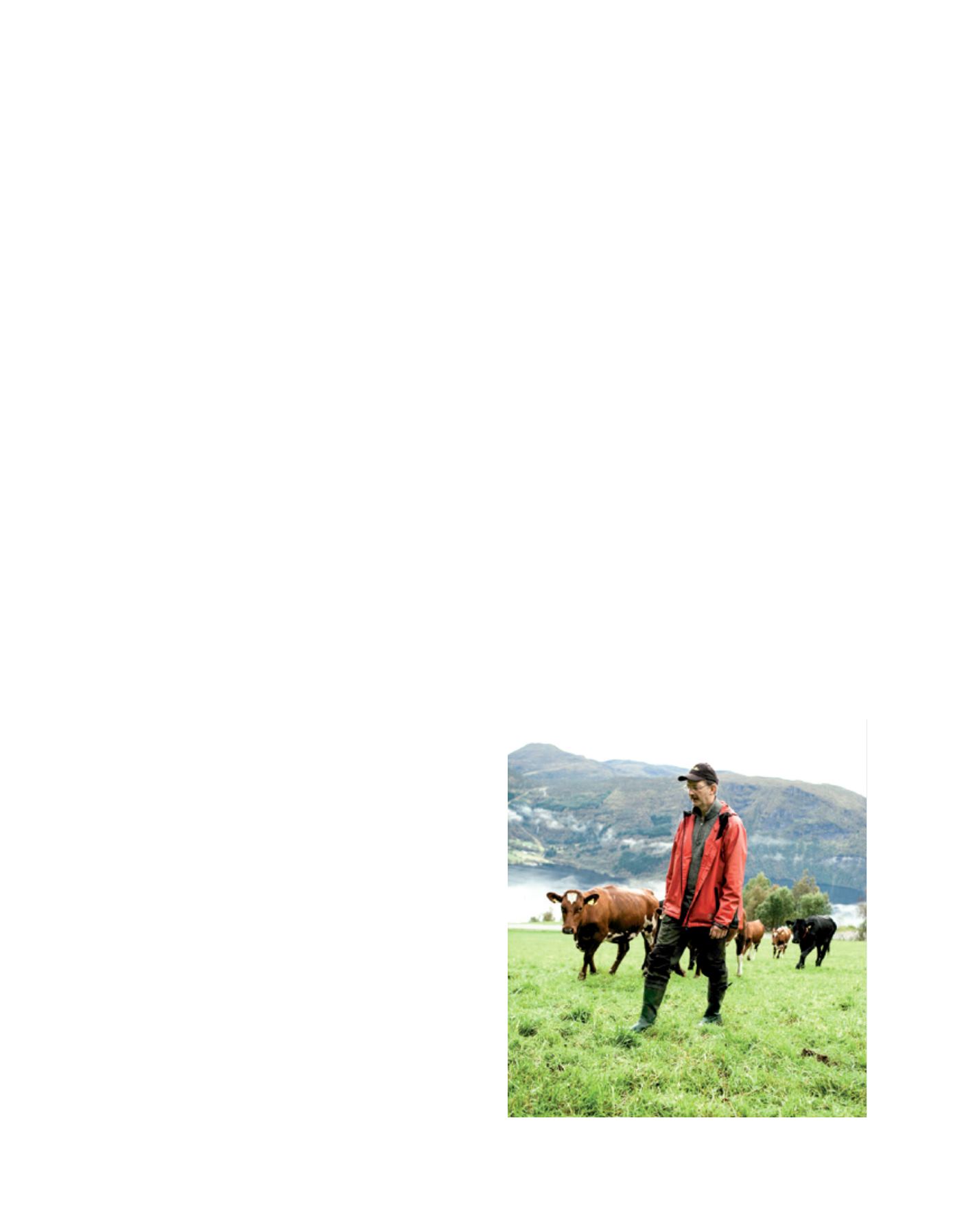

[
] 67
ments, cover the national demand for those products that
naturally grow in the country. The agricultural sector also has
many social objectives. To meet society’s needs, agriculture
must produce safe and healthy food of high quality in the light
of consumer preferences, and produce public goods such as
viable districts, a broad range of environmental and cultural
benefits, and secure long-term food production.
Norwegian agriculture mainly covers the domestic demand
for milk and milk products, pig meat, poultry and eggs.
Norwegian farmers produce 80-90 per cent of the national
demand for beef and sheep meat. The national market share
for grain and potatoes is approximately 60 per cent. Only 25 per
cent of the demand for vegetables, fruits and berries is produced
in Norway. Forestry is also an important part of Norwegian
agriculture. Some 20 per cent of Norway is cultivated forest, a
substantial part of which is owned by family farmers.
Nearly 100 per cent of Norwegian farms are owned and run
on a family basis. The average farm size is 22 hectares. In milk
production the average herd size is 24 cows. Behind these
figures there is a wide range from very small to substantially
larger farms. However, within Norwegian topography, farms
have to be relatively small-scale.
As in all countries, agriculture in Norway need to increase
in efficiency and productivity. The number of farmers has
decreased substantially during recent decades. Farmers
expand their production, to some degree by buying neigh-
bouring farms, but more often by renting land.
Maintaining family farming in Norway
Norway has a long tradition of family farming. However, to
maintain this tradition there is a need for specific measures. In
Norway there are three very important conditions:
• ownership legislation
• agricultural and rural policy supporting family farming
• efficient and well-functioning farmer-owned cooperatives.
Following tradition through centuries, an allodial lawwas adopted
for the first time in 1821. This law gives family members the first
right to buy when a farm is for sale. The first-born son or daughter
has the first right, followed by other members of the family.
The new owner of a farm has some strong obligations. He
or she is obliged to live on the farm for a number of years and
to run the farm or make sure the farmland is properly used by
others. On the other hand, today there is also a price control on
farms. The aim of this is to secure a price level, giving the buyer
the economic ability to live on and run the farm as obliged.
Ownership legislation to keep farms in the family is not
enough to maintain sustainable family farming. The farmer
and his family also need to have enough income to cover
investments and livelihood. To achieve this, national agricul-
tural and rural politics are important.
The production cost for agricultural products is high in
Norway, partly caused by a very high cost level in general and
partly because of the natural conditions for agriculture. To be
able to achieve a price in the market that corresponds with these
costs, an import regulation is necessary. There are high tariffs
on the import of products that can naturally be produced in
Norway. For most other products, tariffs are low, and there are
no tariffs for any product from the least developed countries.
Within the import regulations, it is possible to achieve a
high price in the market. However, the prices are limited by a
target price decided by Parliament after negotiations between
the Government and farmers’ organizations. On the other
hand, it is accepted that the farmers and their cooperatives
use certain tools to achieve the target price.
The agricultural policy also includes direct payments to farmers.
These have strong structure and regional measures, and are essen-
tial for the livelihood of small family farmers in rural areas.
Agricultural cooperatives
The farmers’ products have to be sold in a market, and
processed and packed according to consumer preferences.
Agriculture production takes place in rural areas spread across
the country, while the majority of the consumers live in or
near the cities. Only a few farmers, living near to cities, are
able to bring products directly to the consumer or store.
Most products need processing before they can be sold. One
single small farmer cannot invest in the necessary equipment for
this alone. In addition, if the farmers are going to market one
by one, competition between them will bring their prices down.
Against this background, Norwegian farmers started to
develop their cooperatives more than 100 years ago. Members
cooperated in collecting products from the farmers and
bringing them to market after the necessary processing. The
alternative was to let middlemen take care of the marketing.
But the farmers soon learned that this would not give them a
fair share of the market value for their products.
Today Norwegian farmers have cooperatives in all sectors. They
are mainly organized as single-purpose cooperatives. Starting with
small local cooperatives, through increased cooperation between
cooperatives, each sector now has one national cooperative with
members fromacross the country. Themarket share of the cooper-
Milk and beef are important products based on Norway’s grassland
Image: TINE SA
D
eep
R
oots
















